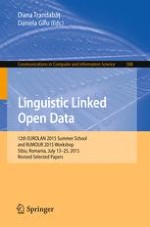2016 | Buch
Linguistic Linked Open Data
12th EUROLAN 2015 Summer School and RUMOUR 2015 Workshop, Sibiu, Romania, July 13-25, 2015, Revised Selected Papers
herausgegeben von: Diana Trandabăţ, Daniela Gîfu
Verlag: Springer International Publishing
Buchreihe : Communications in Computer and Information Science
